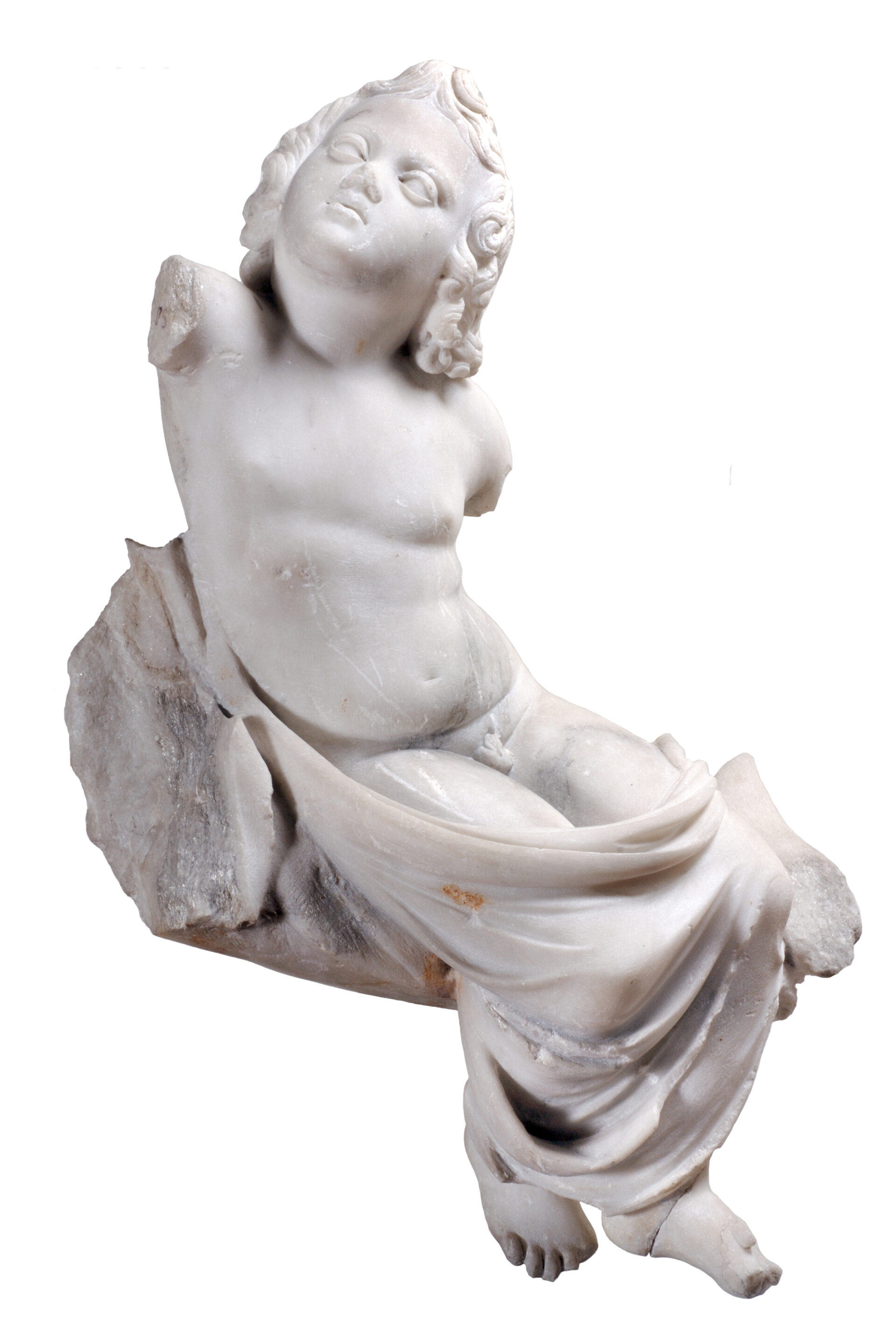Exhibit of the month
Ploutos, son of Demeter – the gift of Eirene
Statuette of baby Ploutos
National Archaeological Museum
Sculpture Collection Inv. No. Γ 175
Provenance: Piraeus
Dimensions: Height 0,65/0,70 m. Width 0,35 m.
Date: Roman period, 1st cent. A.D.
Room 28
Ploutos, the personification of wealth, is depicted as an infant, seated on the left arm of Eirene (Peace), whose figure is not preserved. The statuette belongs to a Roman copy of the famous in antiquity bronze group of Eirene and Ploutos, a work of the sculptor Kephisodotos the Elder, possibly father of Praxiteles (4th c. B.C.). The group is depicted on the Panathenaic amphoras (clay vases-prizes of athletic contests), dated to 360/59 B.C. in the archonship of Kallimedes and as well as in a series of Roman copies.
Eirene, daughter of Zeus and Themis, was depicted as an austere female figure wearing a heavy garment (peplos / peplophoros) holding a scepter on the right hand, as a symbol of a worshipped deity, and carrying the infant Ploutos on the left arm along with a cornucopia (horn of Plenty) full of fruits. According to Hesiod’s Theogony, Ploutos’ mother was the goddess Demeter, therefore he is usually depicted carrying a cornucopia full of fruits, as a symbol of agricultural abundance, that is of the rich harvest (16346).
In the bronze group of Kephisodotos, Ploutos is a chubby baby and the goddess who gives wealth (Eirene)[1] is a divine kourotrophos[2], caring for and protecting his healthy growth, implying that peace is indispensable for the fertility of the land and the well-being of the city.
The rendering of Ploutos as a little child is related to the interest of the artists in the 5th and 4th c. BC. for the world of children and the naturalistic rendering of the different stages of childhood (infant, toddler, teenager). Besides the smaller scale in which children are rendered, they also have disproportionally large head, protruding stomach and soft musculature (statuette of Telesphoros inv. no. 281). The hair frames the chubby face with the high forehead, covers the ears, while the front hair is tied by a ribbon in a knot over the forehead or in a braid running along the central parting. In the antiquity, the ritual cutting of hair and the dedication of the tresses to the protecting deity, marked the transition from childhood to adulthood.
The tender depiction of children in classical art with the detailed rendering of the age features and the elements alluring the expectant adulthood, denote the hope and the longing for the continuity of generations and the future of the community in an era scourged by war and disease. The strong symbolism of Kephisodotos’s work makes the group of Eirene and Ploutos always timely.
[1] La Rocca 1974, 130-131: Εἰράνα, πλουτοδότειρα βροτοῑς (Peace, wealth-giver to mortals) (Lyr. Fr. Adesp. 89 Bgk). Euripides, Βacchae 419, ὀλβοδότειραν Εἰρήναν, κουροτρόφον θεάν (Peace, giver of riches, goddess who nourishes youths). Euripides, Cresphontes, fr. 453n, Εἰρήνα βαθύπλουτε (Peace, with your depths of wealth).
[2] Women nursing and cradling babies on their laps either as kourotrophic deities, protecting and nurturing the growth of the children or as simple nurses, are frequently depicted on terracotta figurines of the Archaic, Classical and Hellenistic periods. In the end of the 5th c. B.C. they appear on the attic grave stelae.
Dr. Kalliopi Bairami
Bibliography
P.D. Valavanis, Panathenaic Amphoras from Eretria. A Contribution to the Attic Vase-Painting of the 4th Century B.C. Αthens 1991 (in Greek).
La Rocca, «Eirene e Ploutos», Jahrbuch des Deutschen Archäologischen Instituts 89 (1974), 112-136
Barbara Vierneisel-Schlörb, “Eirene und Plutosknabe Gl. 219”, in Κ. Vierneisel – B. Vierneisel-Schlörb (επιμ.), Glyptothek München. Katalog der Skulpturen Bd. 2. Klassische Skulpturen des 5. und 4. Jahrhunderts v. Chr., München 1979, 255-273 αρ. 25 εικ. 119-127, ιδίως σημ. 4 αρ. 10.
Ν. Κaltsas – G. Despinis (eds.), Praxiteles: National Archaeological Museum, 25 July – 31 October 2007, exhibition catalogue, Αthens 2007, 191-193, no. 62 (G. Μοstratos).
For depictions of children in art:
Ε. Vlachogianni, “The art of hairstyling: Hairstyles in the Graeco-roman world and their semiology”, in: The countless aspects of Beauty in ancient art, Exhibition Catalogue. National Archaeological Museum, Αthens 2018, 303-316.
L.A. Beaumont, «Constructing a Methodology for the Interpretation of Childhood Age in Classical Athenian Iconography», Perspectives on Children and Childhood, Archaeological Review from Cambridge 13, 2, 1994, 81-96.
Susan Guettel Cole, «The Social Function of Rituals of Maturation: The Koureion and the Arkteia» Zeitschrift für Papyrologie und Epigraphik 55, 1984, 233-244
E.B. Harrison, «Greek Sculptured Coiffures and Ritual Haircuts», in Early Greek Cult Practice, Stockholm 1988, 247-254.
Carol L. Lawton, «Children in Classical Attic Votive Reliefs», in Constructions of Childhood in Ancient Greece and Italy, Hesperia Supplements, 41. 2007, 41-60.
J.H. Oakley, «Τα παιδιά στην αθηναϊκή ταφική τέχνη κατά τη διάρκεια του Πελοποννησιακού πολέμου», Εgnatia 13, 2009, 193-210.
E.G. Raftopoulou, Figures enfantines du musée d’ Athènes, München 2000.


